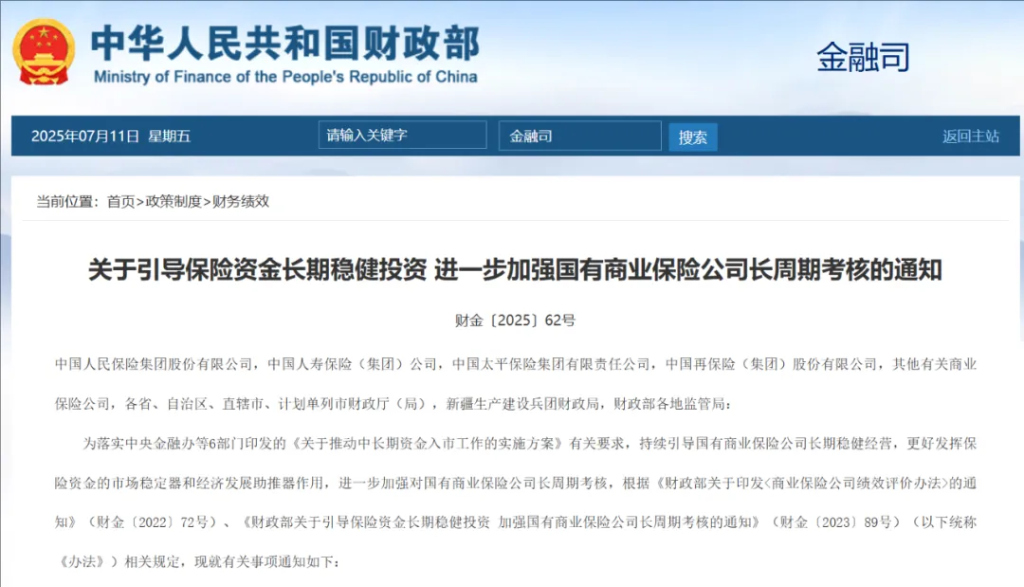
On July 11, the Ministry of Finance issued the "On Guiding Long-term and Steady Investment of Insurance Funds Notice on Further Strengthening the Long-term Assessment of State-owned Commercial Insurance Companies" (hereinafter referred to as the "Notice").

The long-term assessment of state-owned commercial insurance companies has been strengthened. The assessment of return on net assets and capital preservation and appreciation rate has been changed from the original "current year + 3-year cycle" to "current year + 3-year cycle + 5-year cycle". It aims to guide long-term and steady investment of insurance funds, reduce the impact of short-term fluctuations, enhance the enthusiasm for equity investment, and better play the role of insurance funds as "ballast stone".
There are changes in the assessment method: more emphasis is placed on long-term performance
"The Ministry of Finance on guiding long-term and steady investment of insurance funds The relevant provisions of the Notice on Strengthening the Long-term Assessment of State-owned Commercial Insurance Companies (hereinafter collectively referred to as the "Measures") stipulate that the "return on net assets" of the operating efficiency indicators has been adjusted from the assessment method of combining "3-year cycle indicators + current year indicators" to the assessment method of combining "current year indicators + 3-year cycle indicators + 5-year cycle indicators".
In the past, the assessment of the operating efficiency of insurance companies mainly looked at the return on net assets (ROE), and it was evaluated together with the "current year indicators" and "3-year cycle indicators".
Now it is different, the new assessment method has become a combination of three parts:
Current year indicator (current year's ROE): 30% weight
3-year cycle indicator (average ROE): 50% weight
5-year cycle indicator (average ROE): 20% weight
The simple understanding is: you don't make much money this year, only 30%; three years of stability and instability, accounting for half; Whether you can continue to make money in five years has to be counted as two percent. In other words, short-term performance is not fragrant, and long-term "endurance" is the king!
Why did it change so much? Guide the long-term investment of insurance funds: A lot of the money in the hands of insurance companies is the people's pension and security funds, which cannot be used to "speculate in the short term", but must be stable.
Avoid quick success: If you only look at short-term gains, it is easy for the company to take risks and chase hot spots in order to complete the target, which may bury risks.
Encourage long-term value investment: Lengthening the assessment cycle will help promote insurance funds to invest in areas that require time to precipitate, such as the real economy, infrastructure, and technological innovation.
Changes in the assessment method of the state-owned capital preservation and appreciation rate
As mentioned in the "Measures", the "state-owned capital preservation and appreciation rate" in the operating efficiency index is no longer only based on the performance of the current year, but has been changed to combine the assessment method of the current year, the 3-year cycle and the 5-year cycle. Specifically:
Current year's indicator (state-owned capital preservation and appreciation rate of the current year): the weight is 30%
3-year cycle indicator (3-year average state-owned capital preservation and appreciation rate): 50% weight
5-year cycle indicator (5-year average state-owned capital preservation and appreciation rate): weight 20%
Why is this changing? Prevent short-sighted behavior:
If you only look at the current year's performance, the company may take risks in order to achieve short-term goals, or even make some decisions that are not conducive to long-term development.
Encourage long-term steady development: Lengthening the assessment cycle can encourage insurance companies to pay more attention to long-term value accumulation and capital security, rather than blindly pursuing short-term benefits.
Guarantee the safety of state-owned assets: The rate of state-owned capital preservation and appreciation is directly related to the security and appreciation of state-owned assets. In this way, it is possible to ensure that state-owned assets maintain a steady growth over a longer period of time and avoid significant losses caused by market fluctuations or short-term operational errors.
How do you understand these indicators?
Current year indicator (current year's state-owned capital preservation and appreciation rate): This is a direct reflection of the current year's operation, with a weight of 30%. If you perform well this year, it will help a lot with the overall score.
3-year cycle indicator (3-year average state-owned capital preservation and appreciation rate): This part has the largest weight, accounting for 50%. It examines the company's overall performance in the past three years, which can better reflect the company's ability to continue operating.
5-year cycle indicator (5-year average state-owned capital preservation and appreciation rate): Although the weight is only 20%, it reflects the stability of the company over a longer period of time and is an important criterion for measuring whether the company has long-term competitiveness.
Insurance companies must not only be able to "collect money", but also be able to "manage money" and "use money"
Many people think that insurance companies are selling insurance and losing money, but in fact, it is more like a "money manager" - collecting premiums (liabilities) while using the money to invest and make money (assets). Therefore, how to make these two sides better cooperate is the key.
The "Measures" mention that insurance companies should make efforts in three aspects:
1. Term structure matching
Just like when you lend money to others, you have to know when you can get it back; Insurance companies should also know when they will pay claims and surrender fees in the future, and then arrange investment according to this time to avoid the embarrassment of "having to pay back the money before it comes back".
2. Balance between cost and benefit
There is a "cost" to the premiums collected, such as the promised compensation and income to customers; The money invested must also be earned back, and it cannot be lost. In a word: You can't just think about making more money, you have to control risks and be steady.
3. Cash flow is compatible
The simple understanding is that "money coming in" and "money going out" are the right numbers; If suddenly there is a large amount of compensation to be paid, and the money is put in the investment project and cannot come out, it will be troublesome.
The stock market has fluctuated a lot in recent years, and many insurance companies are also adjusting their investment portfolios. This policy also emphasizes one point: equity investments (such as stocks, funds, etc.) can be had, but they should be moderate, rational and strategic.
It's not that you can't buy stocks, but you have to look at: is the market opportunity good? Can you bear the risk? Is it a short-term speculation or a long-term layout? Only by grasping the rhythm can we make money without stepping on thunder.
Achieve the goal: stable growth + preservation and appreciation of state-owned capital. Let the owner's equity grow steadily; Ensure that state-owned financial capital not only "preserves capital", but also "increases in value". To put it bluntly, the money handed over to you by the state cannot be allowed to shrink, and it will get bigger and bigger!
Improve investment management capabilities
This policy clearly requires insurance companies to do the following:
Strictly implement the internal investment system
Just like there are rules for playing games and driving to abide by traffic rules, insurance companies must also have a clear set of "operation manuals" for investment - that is, internal investment management systems. Moreover, this system must not only be implemented in place, but also continuously optimized and upgraded.
Improve the investment decision-making process and risk assessment system
It is not that anyone can vote with their heads, but to: research (due diligence) first; re-analysis (whether the income can cover the cost); Then assess the risk (whether there is a countermeasure if something goes wrong); Finally, decide whether to make a move. Don't fight unprepared battles, don't be "blind throwing" players.
Strengthen risk management, transaction management and post-investment management
Many people only pay attention to "whether they have voted", but the real masters look at "how to vote" and "what to do after casting". Therefore, three links are now emphasized: risk control before investment: prevent problems before they happen; Compliance and transparency in the transaction process: ensuring that every step stands the test of checks; Post-investment tracking management: The project investment is not the end, but the starting point, and it is necessary to continue to keep an eye on the rate of return and risk changes, and if necessary, it is necessary to exit the stop loss in time.
State-owned commercial insurance companies can no longer invest "extensively" in the future, but must drive steadily, see far, and brake like old drivers - from beginning to end, they must be finely managed, not only to make money, but also to be safe.
Jingtai view|Make investment calmer
In the past, we evaluated whether insurance companies invested well or not, and many times it looked at how much it made in a year, which was like an exam only looking at the final results, which could easily lead to "cramming" or "chasing up and down".
But now it is different, the "Measures" propose to implement a three-year or even longer cycle assessment mechanism for medium- and long-term funds such as commercial insurance funds, and: not only to assess the overall performance of investment institutions; It also depends on the performance of specific investment managers and product portfolios; At the same time, it is also necessary to establish a supporting management system to ensure that this set of "slow-paced" assessments can be truly implemented.
In this way, it is equivalent to telling the insurance company: don't rush to make money, come steadily, and see far to go far.





